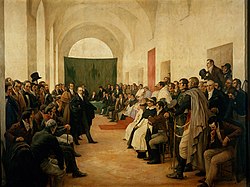
Back Revolución de mayo AN ثورة مايو Arabic Revolución de Mayu AST May İnqilabı Azerbaijani Майская рэвалюцыя Byelorussian Майска революция Bulgarian Revolució de Maig Catalan Mai-Revolution German Revolucio de Majo Esperanto Revolución de Mayo Spanish
| Part of the Spanish American wars of independence | |
 | |
| Date | May 25, 1810 |
|---|---|
| Location | Buenos Aires |
| Also known as | Revolución de Mayo |
| Cause | Popular sovereignty |
| Motive | Abdications of Bayonne |
| Target | Self-governance |
| Outcome | The Primera Junta seize the government, ousting the Spanish viceroy Baltasar Hidalgo de Cisneros and launching a series of military expeditions that began the Argentine War of Independence.[1] The Spanish government deny it any measure of legitimacy and fight to preserve the integrity of the Spanish monarchy. |
The May Revolution (Spanish: Revolución de Mayo) was a week-long series of events that took place from May 18 to 25, 1810, in Buenos Aires, capital of the Viceroyalty of the Río de la Plata. This Spanish colony included roughly the territories of present-day Argentina, Bolivia, Paraguay, Uruguay, and parts of Brazil. The result was the removal of Viceroy Baltasar Hidalgo de Cisneros and the establishment of a local government, the Primera Junta (First Junta), on May 25.
The May Revolution was a direct reaction to Napoleon's invasion of Spain. In 1808, King Ferdinand VII of Spain abdicated in favor of Napoleon, who granted the throne to his brother, Joseph Bonaparte. A Supreme Central Junta led resistance to Joseph's government and the French occupation of Spain, but eventually suffered a series of reversals that resulted in the Spanish loss of the northern half of the country. On February 1, 1810, French troops took Seville and gained control of most of Andalusia. The Supreme Junta retreated to Cádiz, formed the Council of Regency of Spain and the Indies to govern, and dissolved itself. News of these events arrived in Buenos Aires on May 18, brought by British ships.
Viceroy Cisneros tried to maintain the political status quo, but a group of criollo lawyers and military officials organized an open cabildo (a special meeting of notables of the city) on May 22 to decide the future of the Viceroyalty. The Regency of Spain was the prelude to the Spanish Cortes of Cádiz of 1810 and the Spanish Constitution of 1812. All of these Spanish governments considered the Argentine Junta to be insurgent and denied it any legitimacy to govern the territories of the viceroyalty. At the other end, delegates of the Junta refused to recognize the Council of Regency in Spain and established a junta to govern in place of Cisneros, as the government that had appointed him Viceroy no longer existed. To maintain a sense of continuity, Cisneros was initially appointed president of the Junta. However, this caused much popular unrest, and so Cisneros resigned under pressure on May 25. The newly formed government, the Primera Junta, included only representatives from Buenos Aires and invited other cities of the Viceroyalty to send delegates to join them. The revolutionary army began the war and this resulted in the outbreak of a secessionist Civil war between the regions that accepted the outcome of the events at Buenos Aires and those that remained loyal to Spain.[2][3]
The May Revolution began the Argentine War of Independence, although no declaration of independence from Spain was issued at the time and the Primera Junta continued to govern in the name of the king, Ferdinand VII, as a subordinate king to popular sovereignty. As similar events occurred in many other cities of the continent, the May Revolution is also considered one of the early events of the Spanish American wars of independence. The question of the mask of Ferdinand is particularly controversial in Argentinean History. Historians today debate whether the revolutionaries were truly loyal to the Spanish crown, or whether the declaration of fidelity to the king was a necessary ruse to conceal the true objective—to achieve independence—from a population that was not yet ready to accept such a radical change, but there is strong evidence of the truly loyal to the Spanish crown.[4] The Argentine Declaration of Independence was issued at the Congress of Tucumán on July 9, 1816.
- ^ Esposito. The Paraguayan War 1864–70: The Triple Alliance at stake in La Plata.
- ^ Kinsbruner, Jay (2000). Independence in Spanish America: Civil Wars, Revolutions, and Underdevelopment.
- ^ Strachan, Hew (2011). The Changing Character of War. p. 206.
- ^ Rodriguez, Jaime (1998). The Independence of Spanish America. p. 107.
© MMXXIII Rich X Search. We shall prevail. All rights reserved. Rich X Search